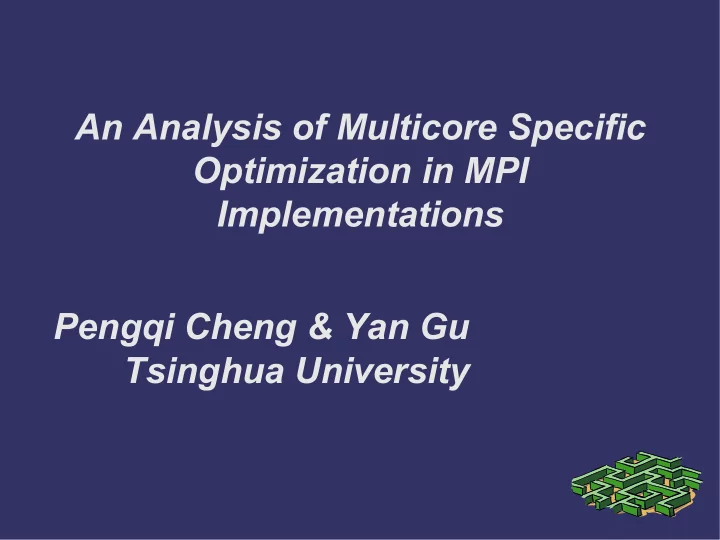

An Analysis of Multicore Specific Optimization in MPI Implementations Pengqi Cheng & Yan Gu Tsinghua University
Introduction ➲ CPU frequency stalled ➲ Solution: Multicore ➲ OpenMP – shared memory ➲ MPI – Message Passing Interface ➲ MPI will be more efficient than OpenMP for manycore – memory wall
Thread-Level Parallelism ➲ Hybrid Programming ➲ Lowering MPI – lack of scalability ➲ MPI + OpenMP / Pthreads / etc. ➲ Advantage ● More control ➲ Disadvantage ● More complexity ● Close to hardware instead of algorithm ● Hard to reuse existed codes
MPICH2 – Implementation ➲ Communication Subsystem – Nemesis ➲ One lock-free receive queue per process ➲
MPICH2 – Location of free queue ➲ One global ● Good for balance on multicore ● Lack of scalability ➲ One per process deq. by one side ● Good for NUMA – less remote access ● Inevitable imbalance ➲ MPICH2 uses the latter ➲ Dequeued by the sender itself
MPICH2 – pseudocode of queue Enqueue (queue, element) prev = SWAP (queue->tail, element); //atomic swap if (prev == NULL) queue->head = element; else prev->next = element; Dequeue (queue, &element) element = queue->head; if (element->next != NULL) queue->head = element->next; else queue->head = NULL; //CAS – atomic compare and swap old = CAS (queue->tail, element, NULL); if (old != element) while (element->next == NULL) SKIP; queue->head = element->next;
MPICH2 – Optimizations ➲ Reducing L2 cache miss ● Both head and tail accessed when ● Enqueuing onto an empty queue ● Dequeuing the last element ● One miss less if head and tail are in the same cache line ● False sharing if more elements ● With a shadow head copy, miss only when enqueuing onto an empty queue or dequeuing from a queue with only one element
MPICH2 – Optimizations ➲ Bypassing Queues ● Fastbox – single buffer ● One per pair of process ● Check fastbox first and then the queue ➲ Memory Copy ● Assembly/MMX in place of memcpy() ➲ Bypassing the Posted Receive Queue ● Checks all send/recv pair instead of matching send to current recv
MPICH2 – Large Message Transfer ➲ Queues have to store unsent data ➲ What if the message is large? ● Bandwidth pressure ● Cache pollution ➲ Rendezvous instead of eager
OpenMPI – sm BTL ➲ Shared Memory Byte Transfer Layer ➲ Transfer fragments of broken messages ➲ Sender fills a sm fragment in its free lists ● Two free lists, for small/large msg. ➲ Sender packs the user-message fragment into sm fragment. ➲ Sender posts a pointer to this shared frag into FIFO queue of receiver. ➲ Receiver polls its FIFO(s). Unpack data when it finds a new fragment pointer and notifies the sender
KNEM – Kernel Nemesis ➲ Linux Kernel Module ➲ Problems of traditional buffer copying ● Cache pollution ● Waste of memory space ● High CPU use ➲ Solution ● Direct single copying in kernel space
KNEM – Implemetation
Experiment Platform ➲ Hardware ● Quad-Core Intel Core i5 750 2.67GHz ● L1: 32KB+32KB per core ● L2: 256KB per core ● L3: 8MB shared ● 4GB DDR3 @ 1333MHz
Experiment Platform ➲ Software ● Arch Linux x86-64 with Kernel 2.6.36 ● GCC 4.2.4 ● MPICH2 1.3.1 -O2 ● No LMT / LMT Only / LMT + KNEM ● OpenMPI 1.5.1 -O2 ● sm BTL, with and without KNEM ● KNEM 0.9.4 -O2, without I/OAT ● OSU Micro-Benchmarks 3.2 -O3 ● 2 processes for one-to-one
Results
Results
Results
Results
Results
Results
Results
Analysis ➲ Nemesis (without LMT/KNEM) ● Best for small messages ➲ sm BTL – best for large messages ➲ Watershed: about 16KB ➲ 16KB~4MB ● KNEM accelerates sm BTL ● But slower for LMT ➲ 4MB+ (larger than L3 cache) ● KNEM makes sm BTL slower ● But improves LMT ● sm BTL > KNEM > LMT for memory ● Will KNEM be better with DMA?
Analysis ➲ LMT > Original Nemesis ● Threshold: 32KB~256KB ● Smaller if more concurrent accesses ● Steep Slopes at 32KB – LMT disabled ➲ How about ● More cores? ● Difference between 1-1 and all- all ● Private cache? ● I/OAT & DMA? ● Will KNEM be faster?
Thank you! Any Questions?
Recommend
More recommend